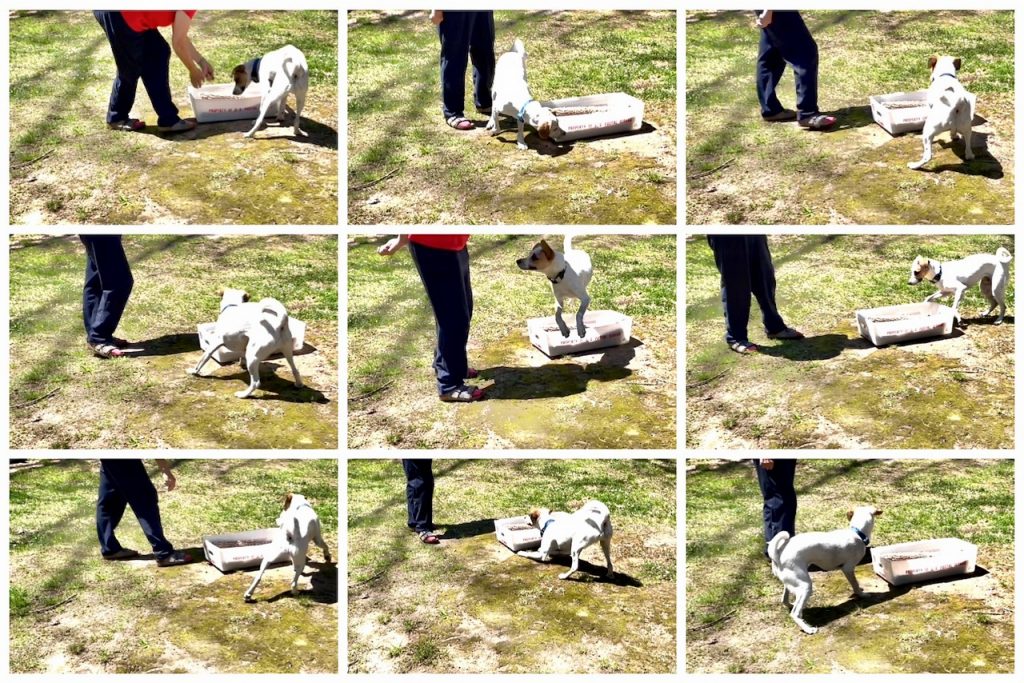
To email subscribers: I have changed my notification service again, which means that you may have to unsubscribe again if you did so from the previous email. I apologize. I hate bothering people. I am now locked into a service for a year so this won’t likely happen again.
I propose that “fallout” may be in the eyes of the beholder. I know that sounds weird, but bear with me and see what you think.
Over 10 years ago, I published a blog page on fallout from the use of aversives in training. It lists definitions and descriptions of the types of fallout that can result from aversive use, all with citations from the literature. It’s a simple page, and a popular one.
But I didn’t define fallout. It wasn’t until recently that I realized I had missed that very important point.
So let’s go!
Definition of Fallout
I couldn’t find a definition in any behavior science textbook, and I think I know why. I’ll get to that later. For now, here is a dictionary definition, which references physics.
Fallout
1. a : the often radioactive particles stirred up by or resulting from a nuclear explosion and descending through the atmosphere
also : other polluting particles (such as volcanic ash) descending likewise
b : descent (as of fallout) through the atmosphere
2 : a secondary and often lingering effect, result, or set of consequences
Murray Sidman
Dr. Murray Sidman popularized the term “fallout” in behavior science in his book, Coercion and Its Fallout (1989). I couldn’t find substantial references to the term in the literature before that. (Someone please correct me if I’m wrong.) He used the term in the sense of the second definition above, but he referenced the first definition. The usage spread across the behavior world.
The following is the closest I could find to an actual definition in Sidman’s book.
A nuclear explosion’s side effects—the extensive radioactive fallout—cause both immediate and long-delayed, but lasting human misery. The suffering that the fallout produces overwhelms any positive benefits of a victory that nuclear warfare accomplishes. The side effects of punishment, too, far from being secondary, often have considerably greater behavioral significance than the hoped for “main effects.” — Sidman, 1989, p. 81
I think it’s accurate to characterize fallout as “side effects.” Sidman emphasized the “long-lasting” part.
Side effect
: a secondary and usually adverse effect (as of a drug)Note that Dr. Sidman’s book was aimed at lay people. It has few references and no reference list, and although it uses some technical language, it’s conversational and full of examples that apply to everyday life.
I’m going to start with one of my own.
An Example of Behavioral Fallout
This is a hard story to tell.
When I was in a Novice obedience class with my dog Summer many years ago, the instructors set up an exercise based on the training methods of the Volhards. We were to heel our dogs by a man who would wave a treat at them. If the dog turned to go for the food, we were to pop their collar with a jerk of the leash. The goal was to punish moving out of position when faced with a tempting distraction. (I won’t editorialize about the fact that we hadn’t taught our dogs yet not to take available food.)
I did as told. Summer yelped and cringed when I popped her collar. I felt awful and didn’t want to do the exercise a second time, but, to my everlasting shame, I did. The second time, Summer’s body language wilted when she saw the man, and she dodged behind me and moved to my right side to avoid him. I was heartbroken and full of guilt that she trusted me to protect her when I was the one who had hurt her. I walked her away from the man. This experience was a turning point in my training. I could not and would not do that again.
Let’s allow poor Summer’s story to help us with analysis. The intent of the exercise was 1) for the dog to learn to stay in heel position because 2) the behavior of moving toward a distraction was punished. The latter was successful. Summer didn’t go for the food the second time. But Summer did not stay in heel position either, which was the overall goal. The fallout, the “unintended side effects,” were avoidance that took her out of heel position and an enduring fear of the man who had held the treat. Besides the obvious tragedy for my dog, fear of a man standing in a competition ring is not a sought-after situation. This was clearly unintended by the instructors as well.
For an example of more extreme fallout, check out this post.
Distinguishing between Sidman’s “Main Effects” and Fallout
Now here’s an odd thing. As positive reinforcement-based trainers, we may conflate the direct, “successful” punishment of a behavior with fallout, because they often look the same. We’re actually not wrong. Often, they are the same—the same behavior. We don’t intend to use positive punishment, but sometimes it happens by accident. We may see, as a result, avoidance behaviors that we did not intend. The difference between an “effect” and a “side effect” is intent.
Let’s say Lucine decides to use an indoor invisible shock barrier to prevent her dog, Jackson, from coming through the kitchen doorway during food prep and human mealtimes. (In case it’s not clear, this is an awful idea.) Jackson quickly learns that going through the doorway results in a shock. His behavior of walking through the doorway decreases. We would see avoidance of the doorway, Sidman’s “main effect” of the punishment.
But Jackson might also stop going through the kitchen doorway even when invited—a side effect. Lucine intended for Jackson to stay away only during human mealtimes, but Jackson won’t go near the door anytime. This could be characterized as fallout. It’s the same avoidance behavior, but it was unintended. I think this is why fallout is not a defined term in behavior science; determining whether a behavior is “intended” or “unintended,” or even whether it is adverse, is subjective. Even Sidman didn’t use “fallout” in his myriad scholarly papers.
Some of the more brutal trainers on social media don’t seem to care at all when a dog is trembling or cowering in fear. We’d call that fallout, but they probably wouldn’t. Someone who values shut-down dogs will find this fallout acceptable, even desirable.
Going further with Jackson: other examples of fallout in this situation could be if he refused to walk through other doorways or walk on flooring that resembled the tile in Lucine’s kitchen. If Lucine was standing near the doorway a few times when Jackson was shocked, then he might avoid her as well. More behaviors than just walking through Lucine’s kitchen doorway were punished.
This fallout is an example of generalization of avoidance, #1 on my list from the fallout from aversives page.
The above is a true story with the names changed. Jackson also developed stress colitis that strongly correlated with the use of the indoor shock—more fallout. This would correlate with #7 on the fallout list: injury. The correlation with the shock was strong: his colitis resolved whenever he was boarded away from home.
Balanced Trainers and Fallout
I looked for discussion online by balanced trainers who might be concerned about fallout from aversive methods. I found one mention, an instruction about how to use aversives without sending dogs into learned helplessness. But instead, I found many trainers claiming there were terrible problems (fallout) caused by positive reinforcement-based training.
We’ve all seen those arguments. I tried to find specifics from them about why a specific training method caused a specific problem behavior. I didn’t find any such specificity. Just general complaints about “permissiveness” and claims that the balanced folks were the saviors of all the dogs the “purely positive” folks had damaged.
So Is There Fallout from Positive Reinforcement?
Is there fallout from positive reinforcement in the sense I talk about above? Behavioral side effects of positive reinforcement training? Maybe even negative ones?
There can be unintended effects. Please read on. If you are like me, they are not what you might have assumed.
There is an interesting article that talks about the “parallel” side effects of aversive and appetitive stimuli/training (Balsam & Bondy, 1983). In the article, they list, with citations, many documented side effects of aversive control. Then they go through these side effects and identify parallels/opposites as side effects of appetitive control.
Before I go on, there is also an excellent rebuttal to this article by Epstein (1985), who points out the authors’ logical fallacy of claiming that the effects of reinforcement and punishment are parallel. According to Epstein, if they were truly parallel, then reinforcement should have positive (as in desirable) side effects, not negative. But I do appreciate their lists of side effects, however we characterize them.
Here’s one example: a classic side effect of aversive use is avoidance. Avoidance of the aversive stimulus itself, the person associated with it, the location, etc. The parallel side effect of appetitive use is approach. Organisms move toward appetitive stimuli (or, if they’re not mobile, have another strategy that brings the stimuli close to them). It’s hard to think of approach as a bad thing. So many of us who own or work with fearful dogs are delighted when we build positive enough associations that the animal will approach.
But approach, especially persistent approach, can be a training challenge.
You see this with trainers who work with zoo animals, equines, or larger dogs. An experienced zoo trainer will teach the big (or prickly, or toothsome) animal in protected contact, maintaining that setup as long as necessary for safety. A skilled positive reinforcement-based equine trainer will teach a horse not to mug and push for the food—first thing. They may also start in protected contact.
You will also see methods by wildlife rehabbers to prevent animals from learning to associate humans with available food. If an animal is to be released, we don’t want it to get attracted to humans. Rehabbers have various mechanisms to prevent the “person predicts food” association. Approach to humans by many wild animals can lead to their quick injury or death.
The images below show a more ordinary problem. This was young Lewis’ first full day in my home. He was desperately needy and trying to figure out how to get positive attention. The Balsam & Bondy article mentions “clinginess” as a problem associated with approach. This was a problem—for about a day. That’s how long it took him to learn how to interact in a way that works better for humans and got him access to the attention and goodies he craved. This is not comparable to the long-term side effects of aversive use discussed by Sidman.



Persistent approach might be good or bad, depending on the trainer’s goals and the stage of the training. This means that I disagree with the title of the Balsam & Bondy article, “The Negative Side Effects of Reward,” (1983) and agree with Epstein’s opinion. But even with those disagreements, the article is worth reading. It has a unique comparison of some effects of appetitive and aversive training. And a bonus: this article, like several others, does not say what the anti-positive reinforcement crowd implies it does because of the title. It’s good to get acquainted with the content.
I said there were “unintended” side effects. That’s true for a lot of us. But the really great trainers know to expect them, and they use them as part of their training plans from the beginning.
Negative, Positive, and Neutral Side Effects
I believe Sidman used the word “fallout” and its intensely negative connotations to communicate with a lay audience. It’s important to keep in mind that avoidance is a functional response. So is generalization of avoidance, which we generally call fallout. But generalization, throwing a wide net of what to avoid, is what allows many wild animals to survive. I would guess that it’s not “fallout” to them.
But wild animals live in a world of many dangers. Our pets and other animals under our care do not (or should not).
I think the main takeaway is that when we are training or interacting with our companion animals, using aversive methods causes suffering—for them. The side effects of positive reinforcement training can be inconvenient at times, generally for us, and they depend on our skill levels. If food is creating unwanted consequences, a skilled trainer can generally use the same food to change the consequences. These side effects need not be long-lasting.
A balanced trainer I met at a trial once complained about my dogs frequently offering behaviors. To me, it’s a good thing; to them it was a negative side effect, a mistake. I wasn’t able to explain then that any positive reinforcement trainer more skilled than I could easily teach their dogs when it’s appropriate to offer behaviors and when it’s not (a.k.a. stimulus control). Again, this is not a long-lasting problem. It’s a training issue that I didn’t choose to address.
Conclusion
So what do you think? I did not expect this outcome when I looked into “fallout.” I thought there would be an operationalizable definition, but I didn’t find one.
Copyright 2025 Eileen Anderson
Related Posts
References
Balsam, P. D., & Bondy, A. S. (1983). The negative side effects of reward. Journal of applied behavior analysis, 16(3), 283-296.
Epstein, R. (1985). The positive side effects of reinforcement: A commentary on Balsam and Bondy (1983). Journal of applied behavior analysis, 18(1), 73.
Sidman, M. (1989). Coercion and its fallout. Boston: Authors Cooperative.
Discover more from eileenanddogs
Subscribe to get the latest posts sent to your email.








